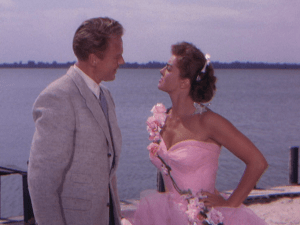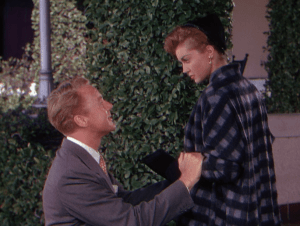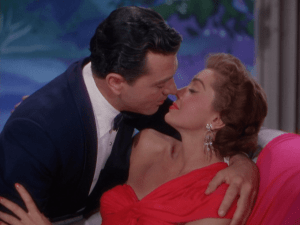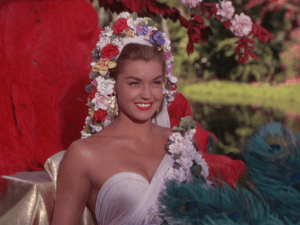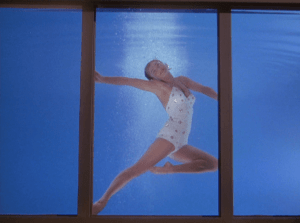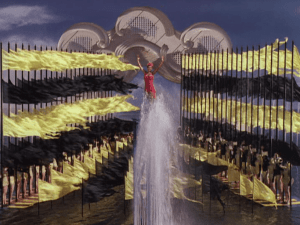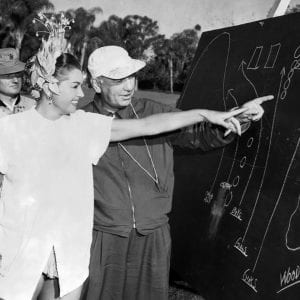
We don’t talk about Esther Williams enough. That’s basically what I’ve been shouting from the rooftops ever since I started learning about Esther in 2013, after her death at the age of 91 encouraged me to take notice of the remarkable life and career of the woman deemed the Million Dollar Mermaid. As a longtime lover of classic Hollywood, I’m used to admiring people and films that are annoyingly, stupidly, and unfairly dismissed by others, but the lack of appreciation for Esther has always stung me the most. Which is why, when I was picked to program a film for IU Cinema’s Staff Selects series, I knew exactly what I wanted to choose: 1953’s Easy to Love. Not only is it a woefully overlooked musical, it’s also one of Esther’s very best. But if that’s not enough to persuade you to join me at the Cinema on March 7, here are seven more reasons that hopefully explain just why Easy to Love is such a lovely delight:
Esther
Okay, so my first reason is a bit obvious. But if you aren’t familiar with Esther Williams, Easy to Love is a perfect introduction to the woman who parlayed her record-breaking career as a champion swimmer into an even more successful career as a movie star. (You can read more about that in a previous post I wrote here.) It’s incredibly hard to distill down into a few sentences why I adore Esther, but here goes: She was a star unlike anybody else. With her natural charisma and powerful athleticism, she worked with her home studio MGM to craft her own genre, the “aquamusical,” which combined elements of musicals, romantic comedies, and water ballets. Esther’s movies were uniquely hers, and they served as a showcase for her persona as an independent, resilient, smart, and highly competent careerwoman.
The pairing of Esther and Van
Esther’s leading men were hit-and-miss. Because the aquamusical was all about highlighting her and her capabilities, her male co-stars were mainly there to sing a few songs and look pretty. And only one of them, third husband Fernando Lamas, could actually keep up in the water without being discreetly held up by her or using hidden ramps to stay afloat. One of her Esther’s best partners, though, was Van Johnson. They first appeared together in A Guy Named Joe with Esther in a small role, but for four more films, they thrilled audiences with their sweet chemistry and undeniable charm. “There was no cuter human being in the world at the time,” Esther wrote about their first meeting, admitting that over time she and Van became like family to one another. Easy to Love was their last collaboration and it’s a marvelous end for such a stunning, underrated screen team.
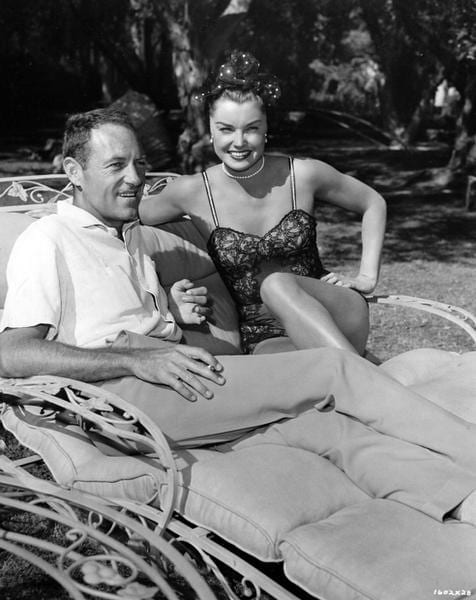
Charles Walters
Like Esther, Charles Walters is not as well-known as he should be. It’s likely you’ve seen one of his films because the man directed one gem after another: Good News (1947), Easter Parade (1948), The Barkleys of Broadway (1949), Lili (1953), High Society (1956), Please Don’t Eat the Daisies (1960),The Unsinkable Molly Brown (1964)… Despite his illustrious career, which included dancing with Judy Garland in Presenting Lily Mars and Girl Crazy, Walters’s name doesn’t get as much recognition as his peers, like Vincente Minnelli. However, he left an indelible mark on classic film. In addition to his excellent directing, he had been a dance director for such movies as Gaslight and Meet Me in St. Louis (both 1944) and he did uncredited directorial work on Annie Get Your Gun (1950) and Gigi (1958).
Esther and Walters made three films together and he was easily her best director, as well as a close friend. Walters called her “a dear dame… the only actress I know who became [a star], really, in spite of herself. But she made a big effort to learn, and she made progress from film to film.” Esther returned the compliment: “He’s the first director who has ever helped me with my acting. It’s a whole new world. … Working with him is like going to drama school. It’s wonderful.” Indeed, Esther hated that most of her directors didn’t respect her as an actress, instead choosing to see her as a talentless girl who knew how to swim. From the second she signed her MGM contract, she worked extremely hard to prove the studio’s faith in her and the fact that Walters saw that meant a great deal to her.
The aesthetics
In an aquamusical, the world is a bright, candy-colored place with impeccable set design and to-die-for clothes, including a myriad of exquisite bathing suits and matching hairpieces, as exemplified by Easy to Love. Shot on location in Cypress Gardens, Florida, the film is filled with such gorgeous imagery as Esther swimming underwater in a glittering polka-dotted swimsuit against a blue backdrop; the ravishing shades of orange, pink, and red found in various sets and costumes; and the lushness of the Gardens’ flora and lakes. Esther’s movies are feasts for the eyes and you can trust me when I say that Easy to Love will be dazzling on the Cinema’s giant screen.
The songs
Although Easy to Love is named after and features the famous Cole Porter tune, its score was primarily written by Vic Mizzy and Mann Curtis. (Fun fact: Mizzy is most known for writing the theme songs for The Addams Family and Green Acres.) Curtis and Mizzy’s songs didn’t become huge hits outside of the film, but they’re still very catchy and pleasing to the ear. It helps that they’re all sung by Tony Martin, who plays one of the men pursuing our girl Esther. Martin is absolutely bewitching as he seductively and playfully croons his way through the story, leaving audiences enraptured on and off the screen.
Busby Berkeley
In addition to Chuck Walters and Van Johnson, another one of Esther’s favorite collaborators was Busby Berkeley. Before she even got in the movies, Esther was enamored with Berkeley’s surreal, spellbinding work; after she became a star, she was excited to see that work up close. “I knew I needed someone with a real sense of showmanship if my movies were to continue to be successful,” she wrote in her autobiography, calling Berkeley “one of the most creative individuals in Hollywood, maybe the only true genius I would ever work with. I could see that at once. More than that, he loved what I did in the water.”
Berkeley crafted some of the most iconic, intense moments in Esther’s career. She personally requested him when a lot of people looked at him as just a washed-up drunk, and in return, he helped ensure her legacy as Hollywood’s mermaid. The twosome collaborated on three films, including — you guessed it! — Easy to Love. If there is anything this film is famous for, it is the seven-minute water-skiing spectacular that acts as its finale. Although Esther did learn how to water-ski for her role, which required a whole different skillset than swimming much to MGM’s ignorance, the actress was also pregnant during production and forced Berkeley to use a double for the jaw-dropping 80-foot dive from a helicopter that you see in the film.
In my opinion, while the finale is truly arresting, my favorite Berkeley setpiece comes earlier, when Esther and John Bromfield’s characters are performing a steamy pas de deux in a lagoon setting for a travelogue. Even though the scene is devoid of half-naked chorus girls and mind-bending geometric images, it still has some of the classic Berkeley touches, such as a lavish set, complete with gypsy violinists and massive floral blankets, and an undeniable eroticism. Esther’s water routines always seemed to get by the censors, probably because it just looked like harmless swimming, but with scenes like this one, it’s hard to ignore the sensuality her movies often displayed.
Esther’s films are rarely screened
Part of the reason why I wanted to program an Esther Williams film is because I’ve never seen her on the big screen. Except for two instances, I haven’t even heard about any other theater or film festival playing her work. I can’t say for sure that I know why this is — I’d venture that it’s because her movies are sadly forgotten and also that they’re tough to access in the right format — but it just makes me all the more grateful that IU Cinema will be able to help me pay some small tribute to the woman who has brought so much light and happiness to my life these past seven years. I can only hope that when you see Easy to Love, the effect Esther has on you is the same.
Easy to Love will be screened at IU Cinema on March 7 as part of the Staff Selects series.

Michaela Owens is thrilled to be the editor of A Place for Film, in addition to being IU Cinema’s Publications Editor. An IU graduate with a BA in Communication and Culture, she is pursuing an MA in Cinema and Media Studies and has also been a volunteer usher at IU Cinema since 2016. She never stops thinking about classic Hollywood, thanks to her mother’s introduction to it, and she likes to believe she is an expert on Katharine Hepburn and Esther Williams.
